Arachtober in Action: Amazing Photos of Spiders from Around the World
It's October, and for photographers on the photo-sharing site Flickr that can mean only one thing: It's the perfect time to share amazing pictures of spiders! Members of the Arachtober group have been posting their best spider shots on the site for eight years, and this year some members have also begun sharing their photos with the hashtag #Arachtober on Twitter. Here are some of the coolest shots of the eight-legged critters from the photographers and researchers who participate in this yearly photo exchange. [Read the full story about Arachtober] (All photos used with permission.)
Halloween Weaver
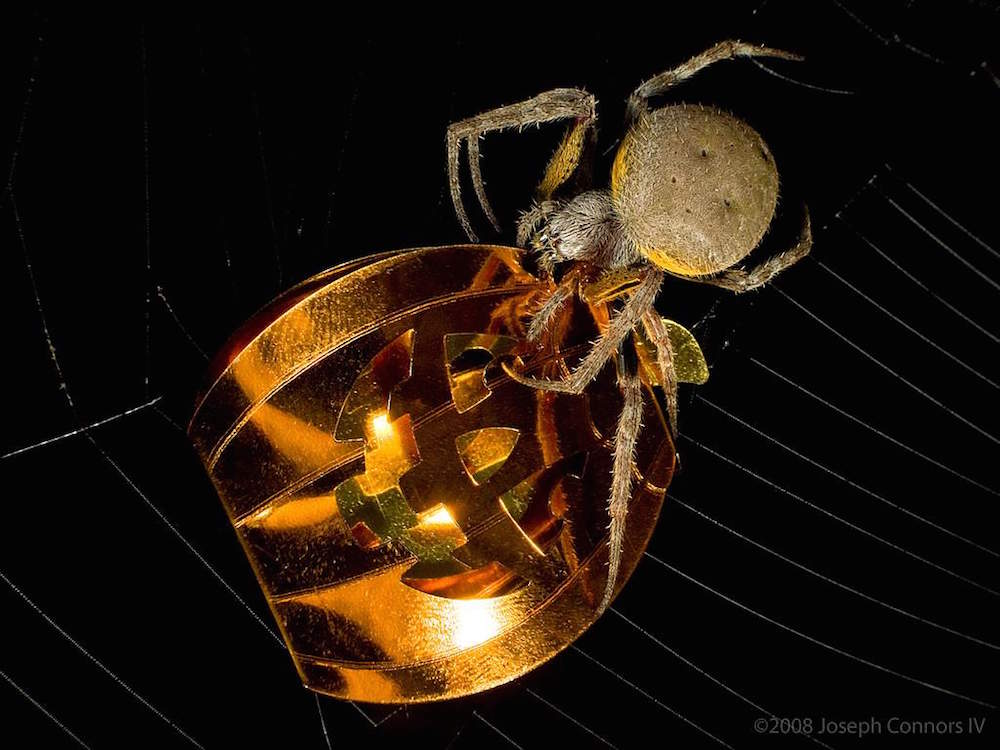
Tropical orb-weaver, Eriophora ravilla
"This species is very common where I live [in Texas], so I end up taking many photos of them. Females can reach an inch long with webs that can span several feet. My dad got a surprise one morning when he nearly walked into one that had been built across the doorway overnight. There is a lot of variety in the coloration and pattern of this species. They are also much more colorful when they are young, often having a bright green patch on their abdomen. It took me a long time to realize those were the same species. Happy Halloween!" [Credit: ©Joseph Connors IV]
(Egg)cellent Shot
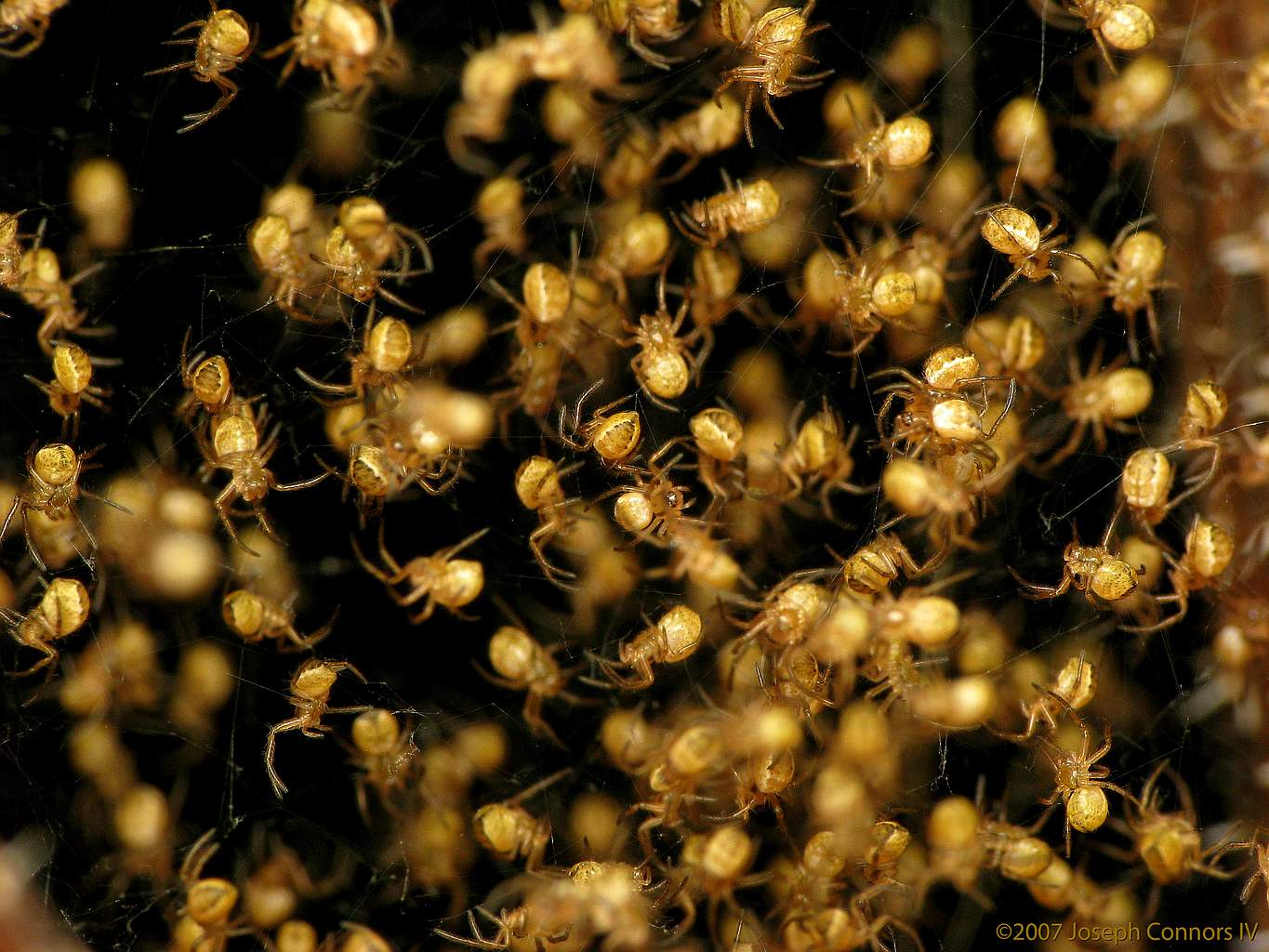
Silver Argiope, Argiope argentata
"I watched these guys' mother for three months in my backyard. She never moved her orb web more than a few feet. In that time, I saw her regrow two missing legs, which can be done when spiders molt. She produced a number of egg sacks, so I got to see new babies several times. Spider babies are one of my favorite subjects. They are really cute at around 2 millimeters [0.08 inches] each. As adults, the females can measure over an inch long." [Credit: ©Joseph Connors IV]
Sign up for the Live Science daily newsletter now
Get the world’s most fascinating discoveries delivered straight to your inbox.
Bright Green Jumper
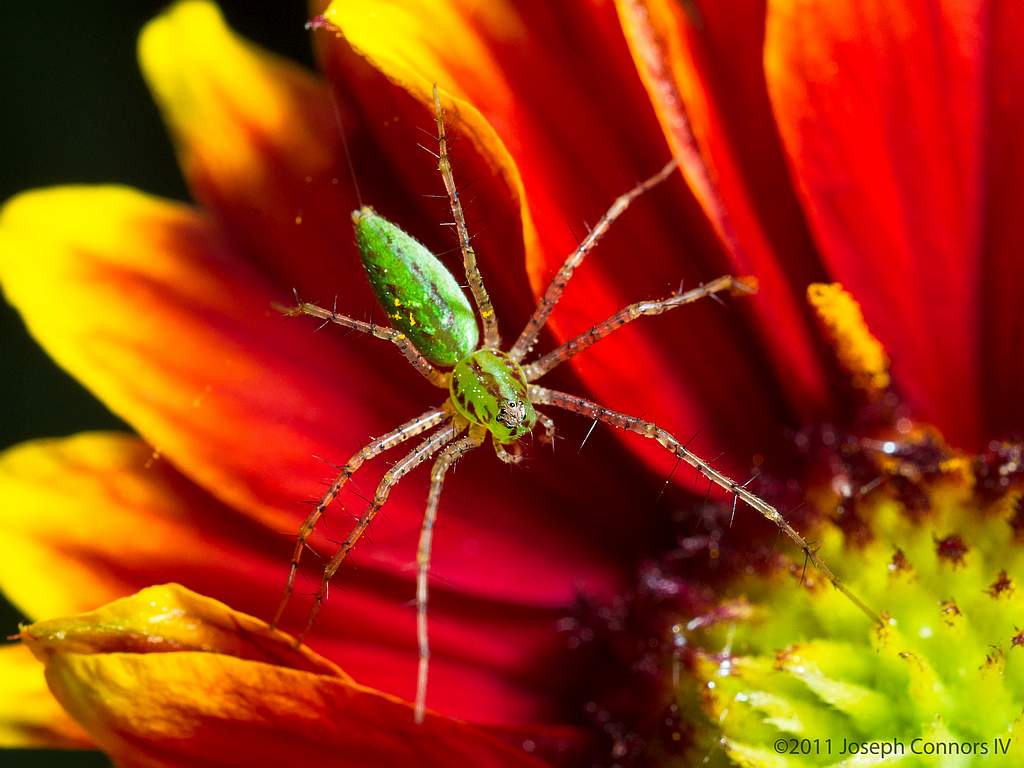
Green lynx, Peucetia viridans
"Because of their bright green color, I really enjoy finding these. When I do, they are generally quite cooperative subjects. They are often found blending in on green leaves. These spiders hunt during the day by jumping at their prey. They are found in the southern United States down through Central America." [Credit: ©Joseph Connors IV]
Excellent Subject
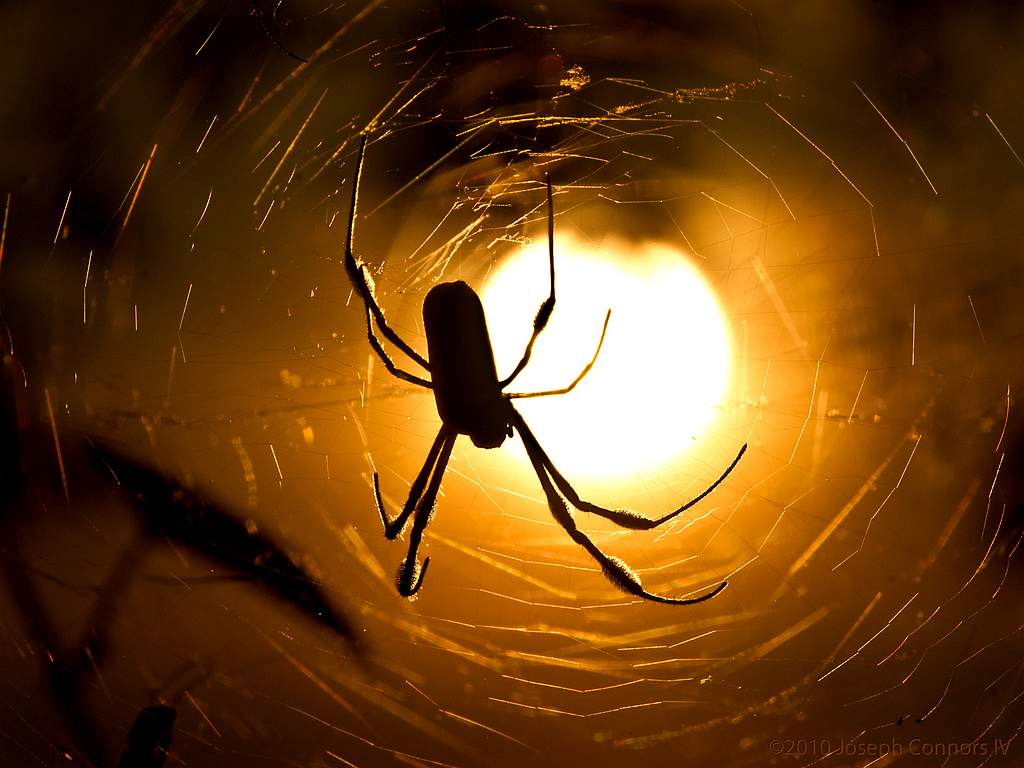
Golden silk orb-weaver, Nephila clavipes
"Commonly known as the 'banana spider,' this species helped get me into nature macro photography because they are excellent subjects. They are large, colorful, easy to find and mostly hold still for photos. Their webs can span several feet. They are found in the southeastern U.S. as well as Central and South America." [Credit: ©Joseph Connors IV]
Camouflage Crabs
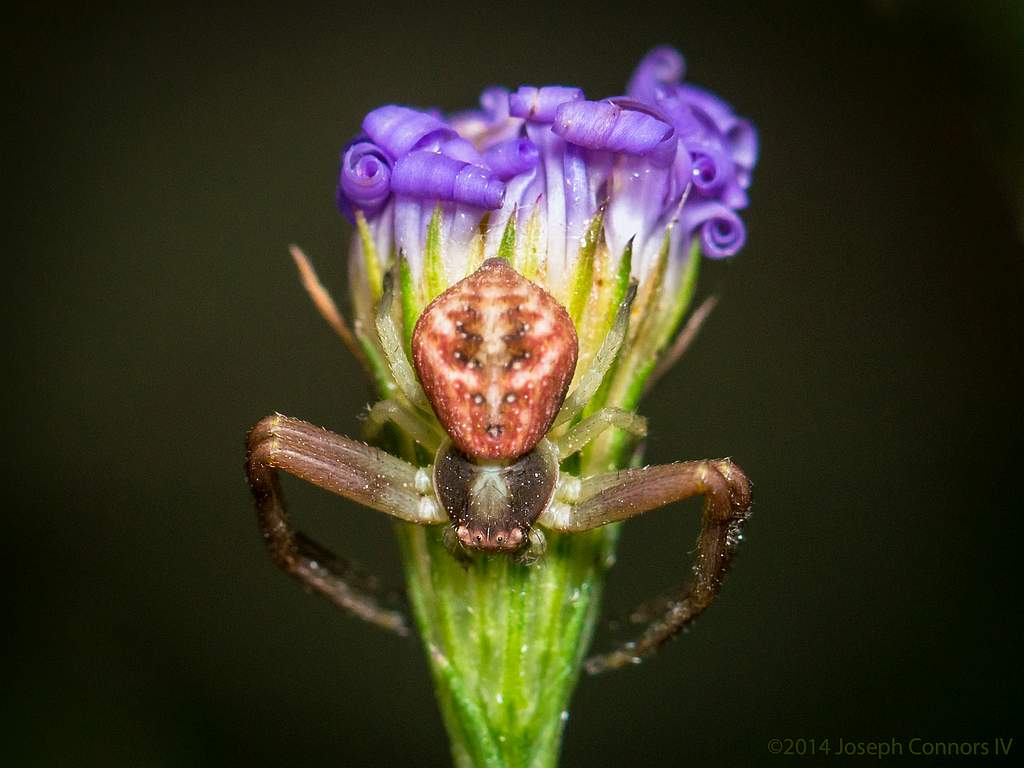
Crab spider, family Thomisidae
"These spiders can be found worldwide, and are probably the type I most often find. They do not build webs, but instead wait to ambush prey, often on flowers. Their colors and patterns vary and usually provide great camouflage; some species can even change color over several days. When I can find one on a flower with contrasting color, that can make a great photo." [Credit: ©Joseph Connors IV]
Spitting Skulls
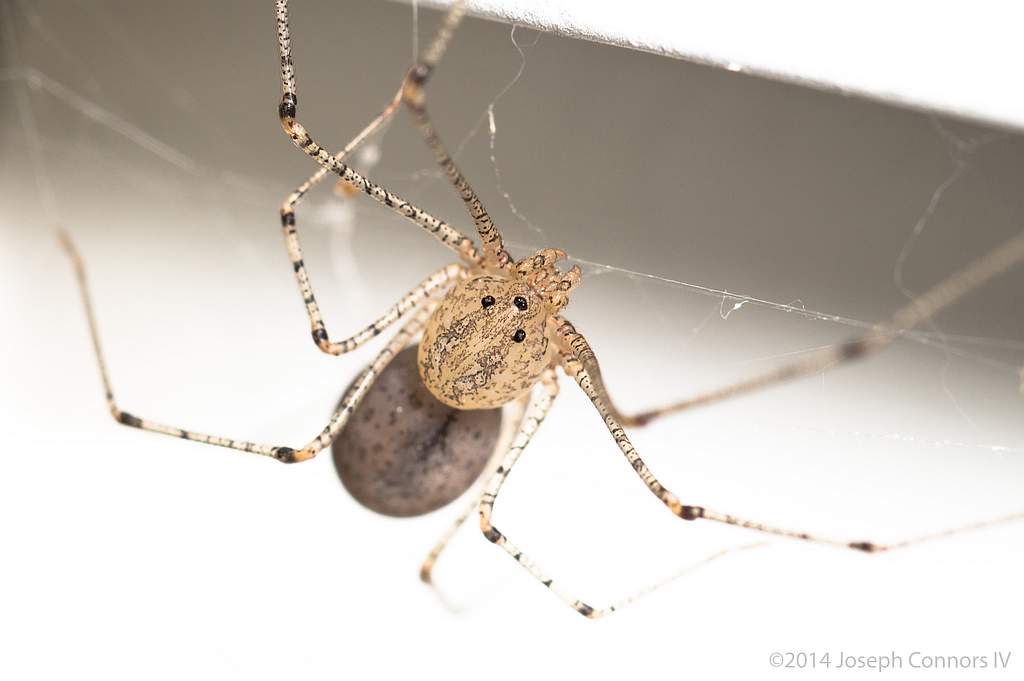
Spitting spider (Scytodes sp.)
"Unlike most spiders, these only have six eyes, which makes their faces look like skulls to me. Their common name comes from their method of catching prey by spitting sticky venom. I have never been spit at, but I read they can spit more than 10 times their body length (so maybe a few inches). I always find them on vinyl siding at my grandparents' house [in Louisiana], living between the slats. They come out to hunt at night." [Credit: ©Joseph Connors IV]
A Scary Surprise
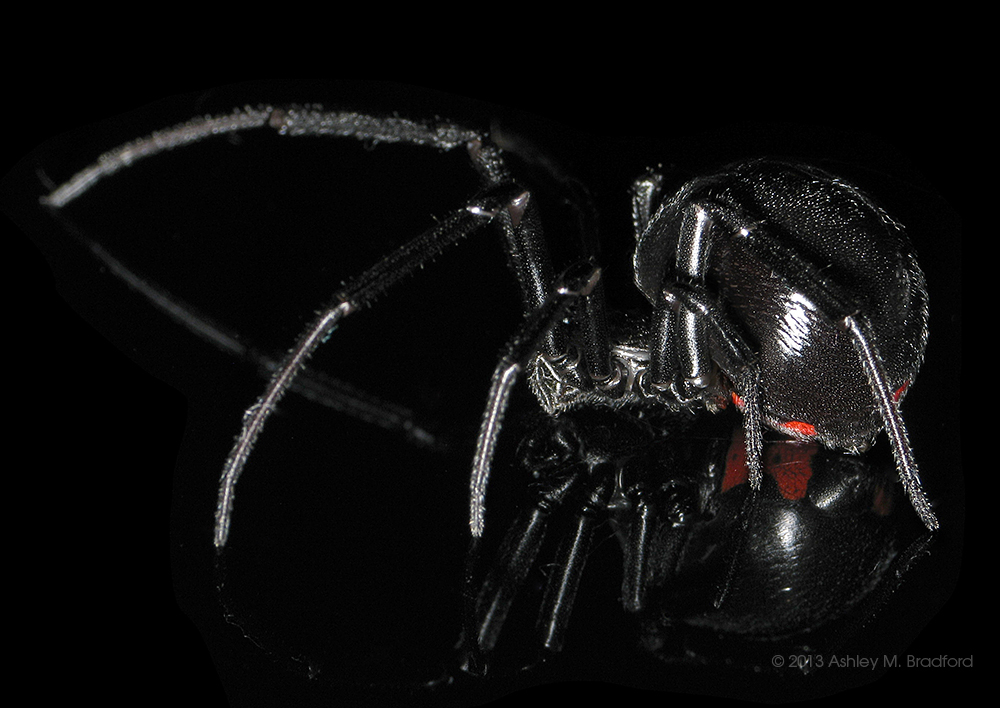
Southern black widow, Lactrodectus mactans
"Found in a web at the bottom of a friend's shower curtain in Alexandria, Virginia. He knew I like photographing spiders, so he gave her to me. I was nervous to have her out, free on my table, but then I found she moved slowly. I learned that black widows have very poor eyesight, and so they don't care to wander much. They find a corner they like, set up house and stay there." – Ashley M. Bradford [Credit: ©Ashley M. Bradford]
Marbled Wonder
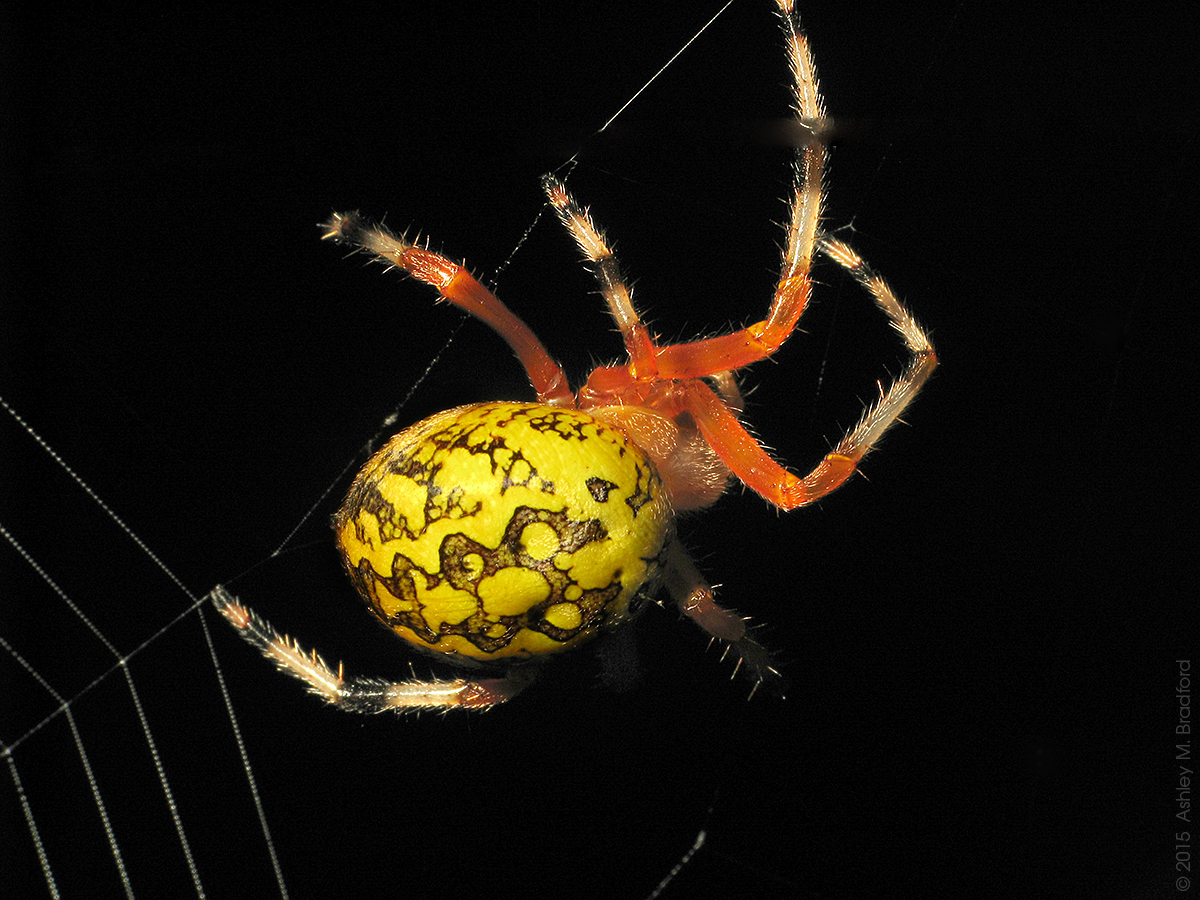
Marbled orb-weaver, Araneus marmoreus
"I regularly stalk the woods of Huntley Meadows Park [in Fairfax County, Virginia] with my camera, and spotted this bright beauty between two trees near the beginning of a boardwalk leading out into wetlands. She's a richly colored adult female of the species, and her orange and black legs make me think of Halloween." – Ashley M. Bradford, [Credit: ©Ashley M. Bradford]
Jolly Green Jumper
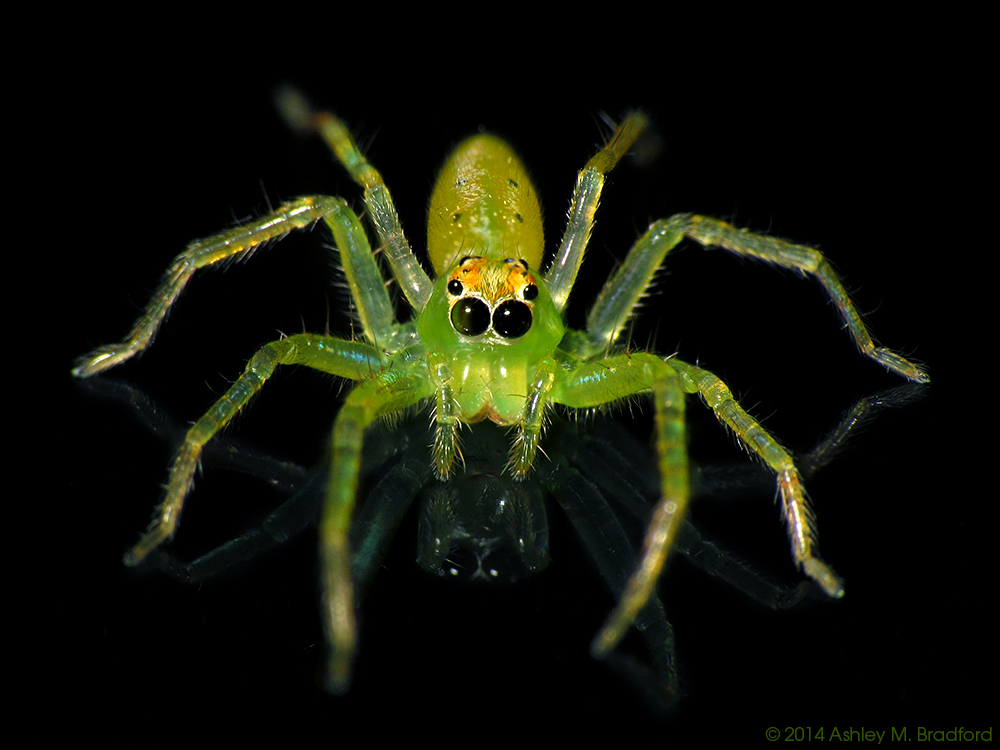
Magnolia green jumper, Lyssomanes viridis
"After years of seeing photos of these and thinking they must be some exotic tropical species, I was surprised to start finding them right in my own backyard. This one is a tiny juvenile, and as you can imagine, they blend in well with foliage. They are jumping spiders, which hunt on foot rather than making webs. Their eyesight is better than other species', and they tend to look right at you when they notice you notice them, making for photographs like this one." – Ashley M. Bradford [Credit: ©Ashley M. Bradford]
Smiley-Faced Wanderer
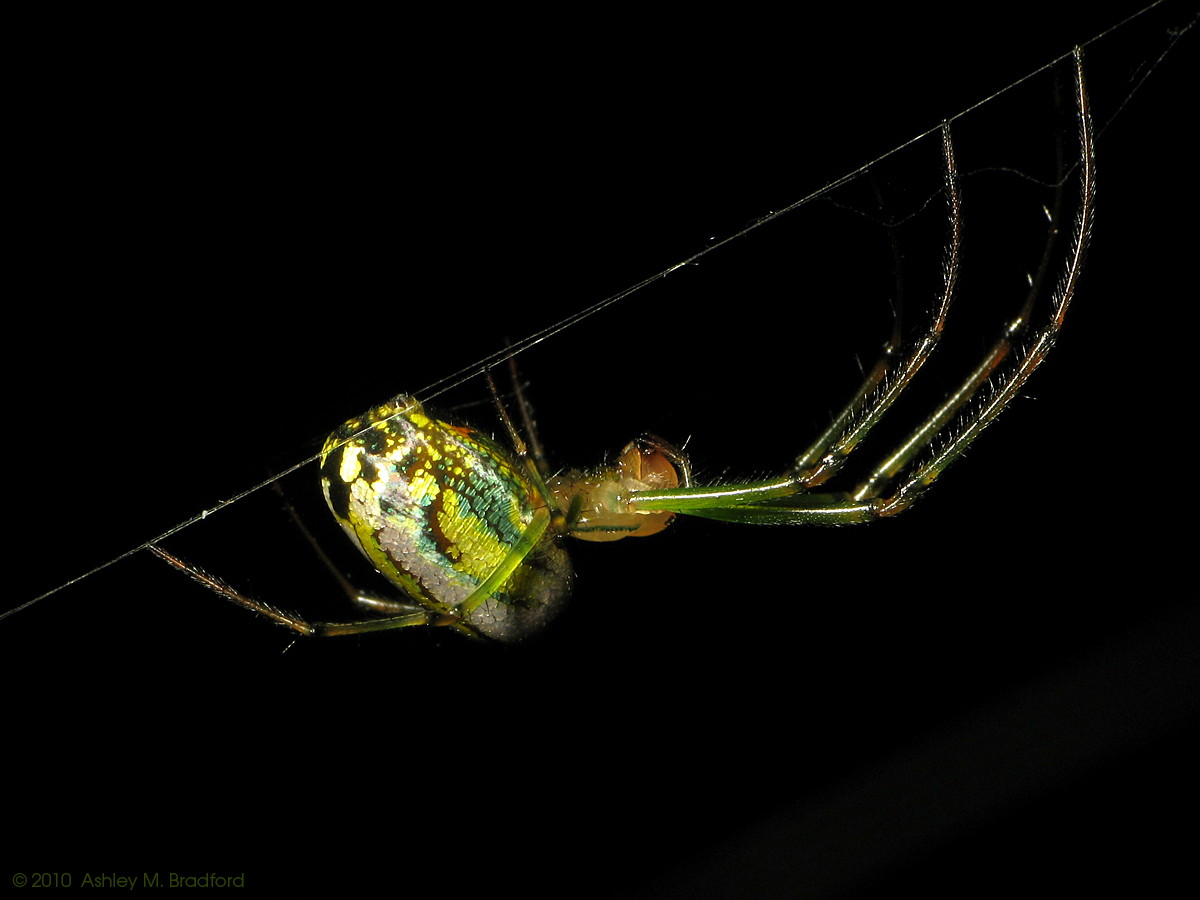
Orchard orb-weaver, Leucauge venusta
"Another one found at my local park and wetlands. These spiders are common throughout the entire eastern half and into the center of the U.S. — from up into Canada to down in Florida. They are a beautiful green color, and their silvery abdomens have pretty patterns of yellow, green and red. The red markings are distinctive, forming a smiley face on the bottom, visible even on the smallest young." – Ashley M. Bradford [Credit: ©Ashley M. Bradford]
Feisty Fellow
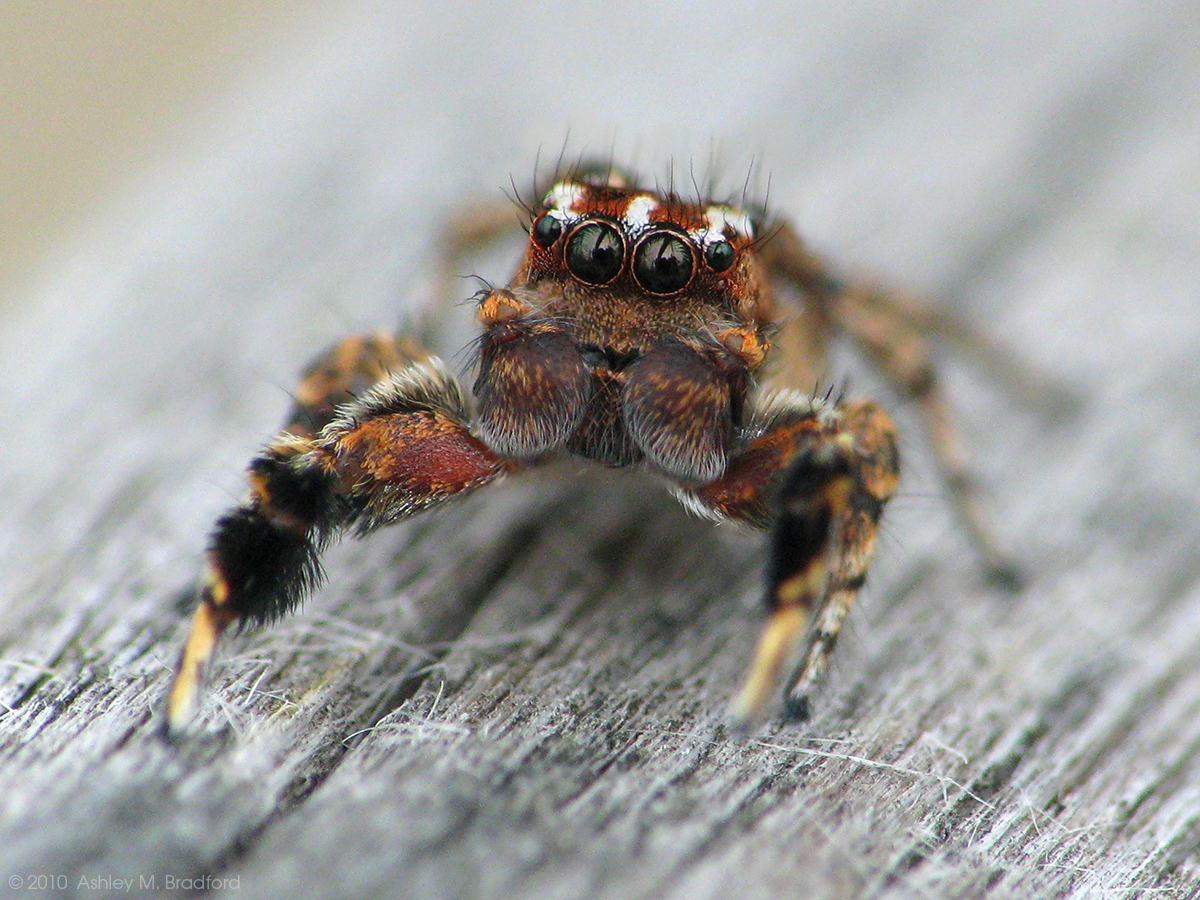
Jumping spider, Habronattus agilis
"I found this feisty fellow on a wooden railing near the shore. You can tell he's an adult male because he has 'boxing gloves' – those are his palps [or pedipalps]. On juvenile and female spiders, the palps are thin, looking like a pair of small legs. As with most other jumping spiders, he was very attentive to my presence." – Ashley M. Bradford [Credit: ©Ashley M. Bradford]
Tiny Surprise
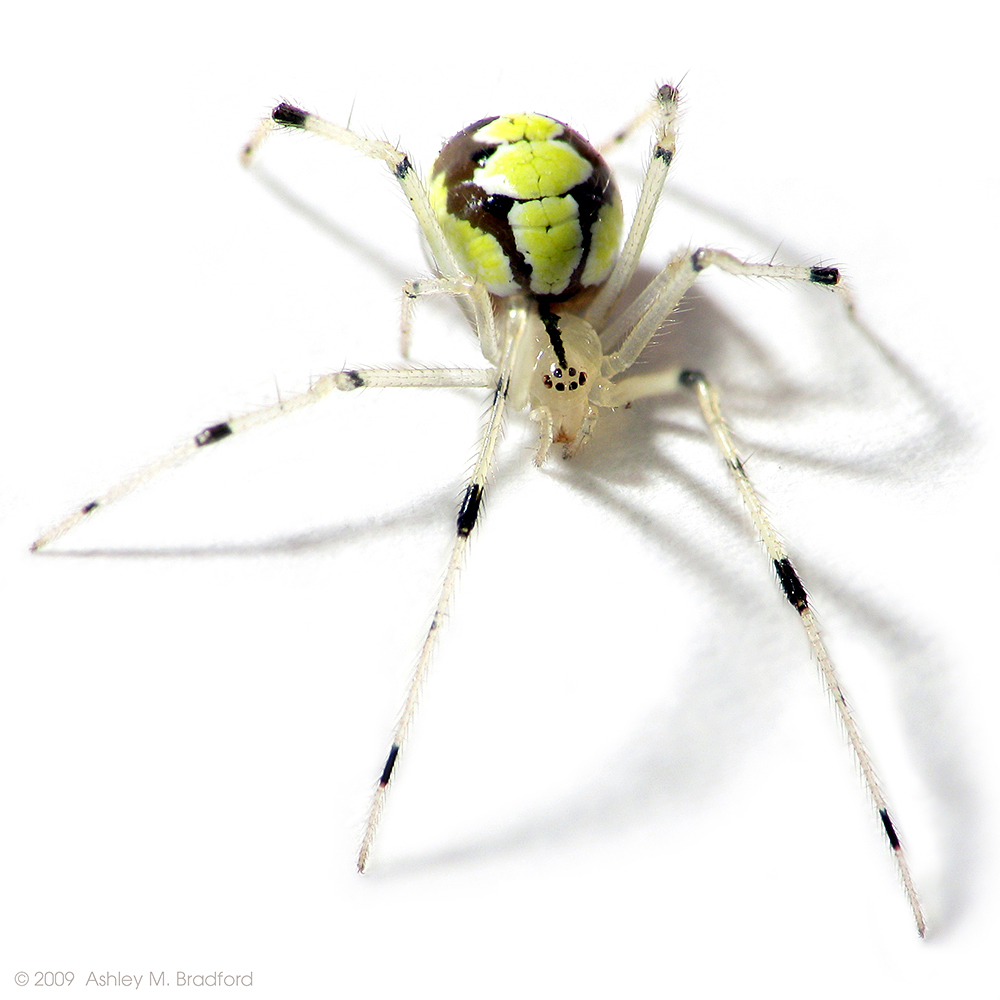
Cobweb spider, Theridion frondeum
"I was surprised to find this exotic-looking spider right in my own suburban backyard and immediately brought her in for a photo shoot. She's in the same family of spiders as both the harmless common house spider, as well as the infamous black widow. They are all cobweb spiders, which means they build a messy and disorganized web." – Ashley M. Bradford [Credit: ©Ashley M. Bradford]
Stunning Jumper
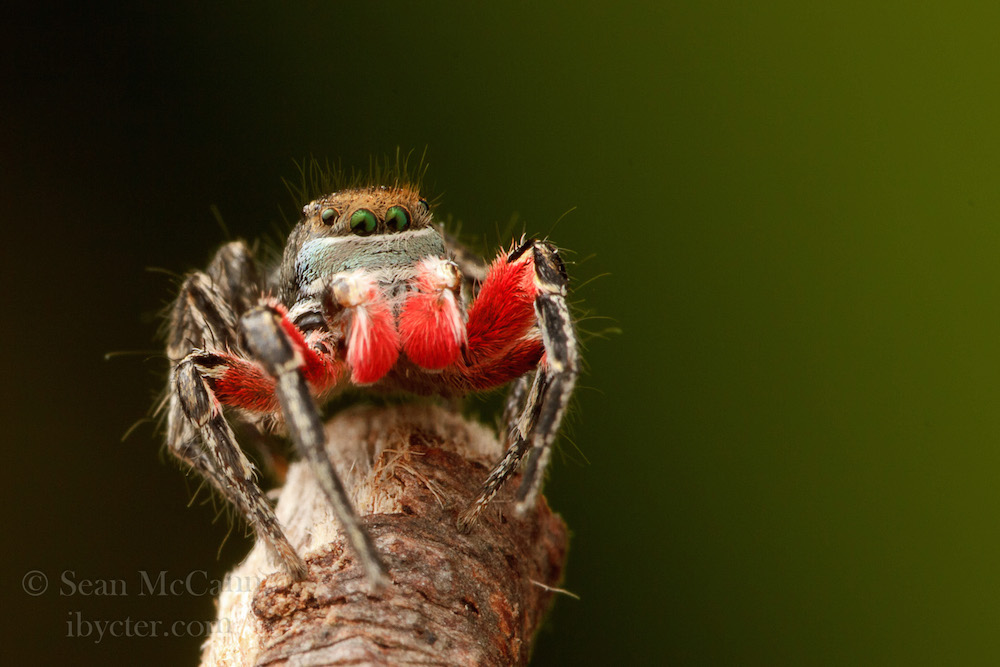
Jumping spider, Habronattus americanus
"I think my favorite spider image that I have shared so far is this picture of Habronattus americanus — just a stunning little jumping spider found in western North America. It is a gorgeous animal, and definitely as pretty as the peacock jumpers of Australia. If people realize they can find these things almost in their backyards (I found this one at a regional park near Victoria, B.C., in Canada), well, that has got to be some motivation to go out and explore!" — Sean McCann [Credit: ©Sean McCann]
Twiggy
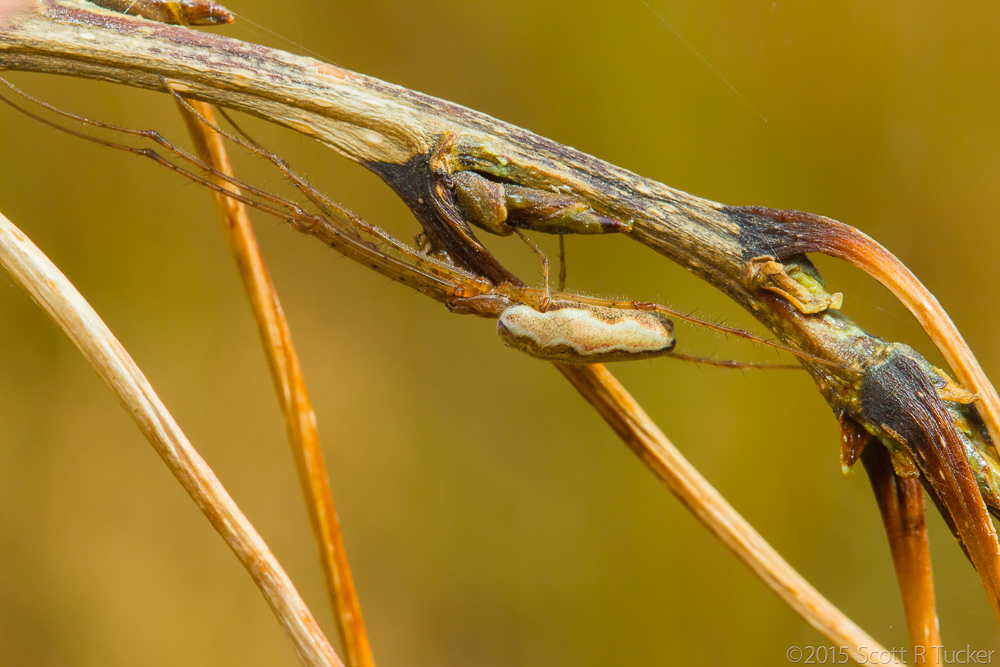
Long-jawed orb-weaver, family Tetragnathidae
"After a long photo session this long-jawed orb-weaver decided she'd had enough of me and tried to hide by becoming another twig on this branch. Is it just me or do these creatures totally resemble a squid when they fold up their long legs like this?" — Scott Tucker [Credit: ©Scott Tucker]
Secret Hideout
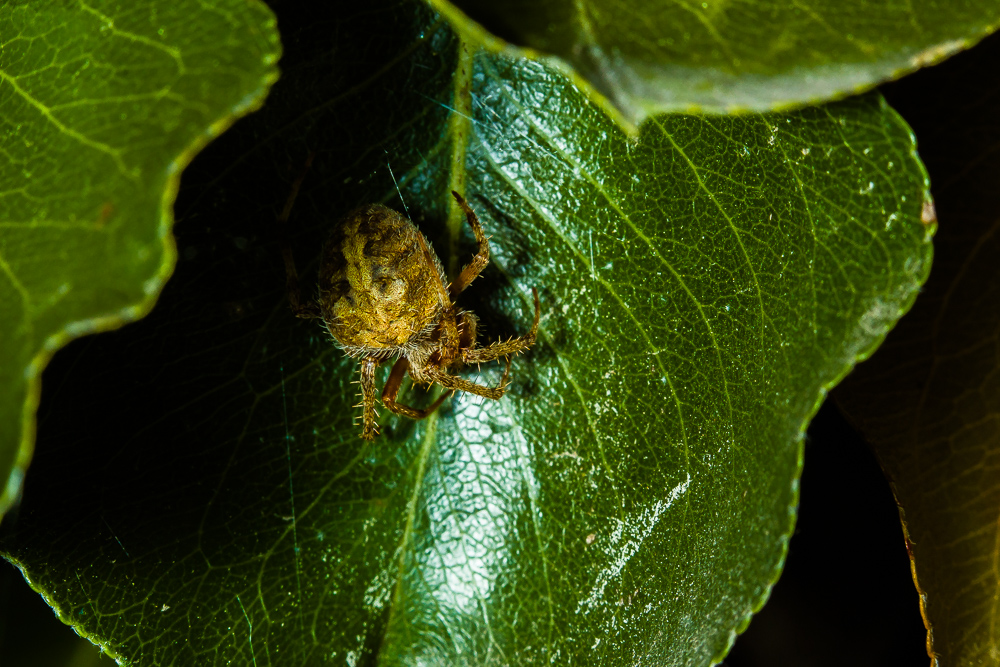
Hent's orb-weaver, Neoscona crucifera
"This weaver had a nice web below. She retreated to this leaf on my pear tree [outside of Denver, Colorado] to hide." — Scott Tucker [Credit: ©Scott Tucker]
Rainbow Spinner
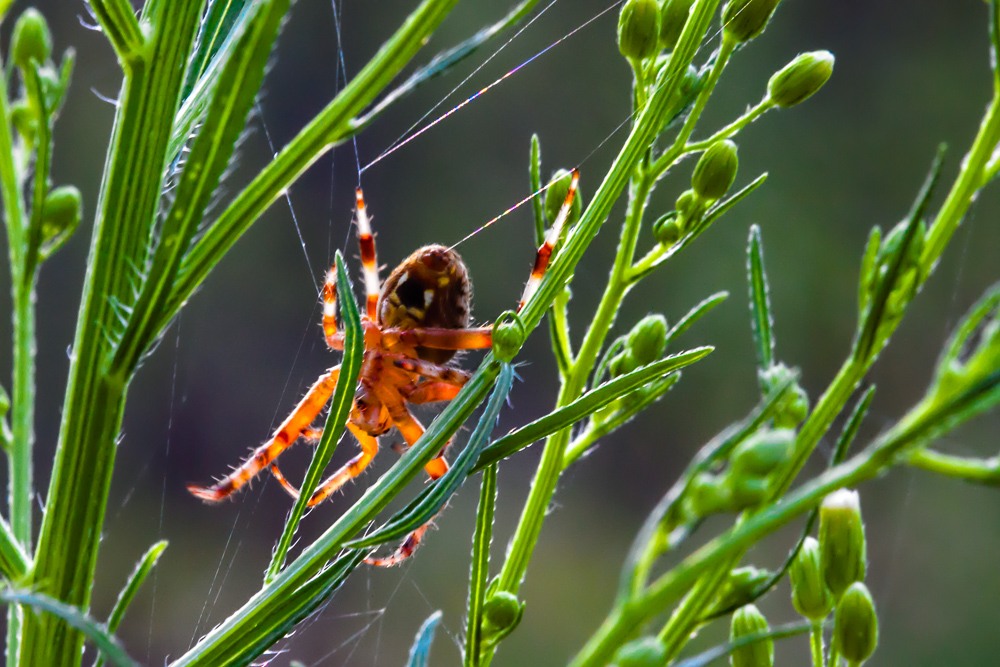
Orb-weaver
"When I was shooting this I saw the translucence of the backlit spider, and the rainbow silk was a bonus from the morning sun backlighting its web." — Scott Tucker [Credit: ©Scott Tucker]
The Lair
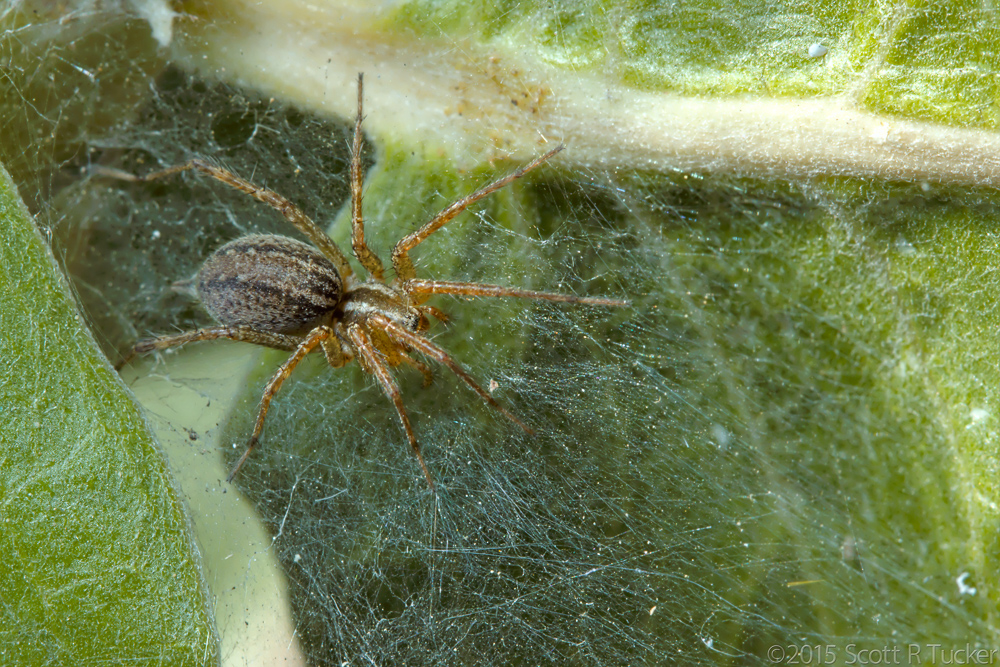
Grass spider, Agelenopsis sp.
"Just behind this beauty is her cave in this leaf. Moments later she shot back in there." — Scott Tucker [Credit: ©Scott Tucker]
Jumpy Little Guy
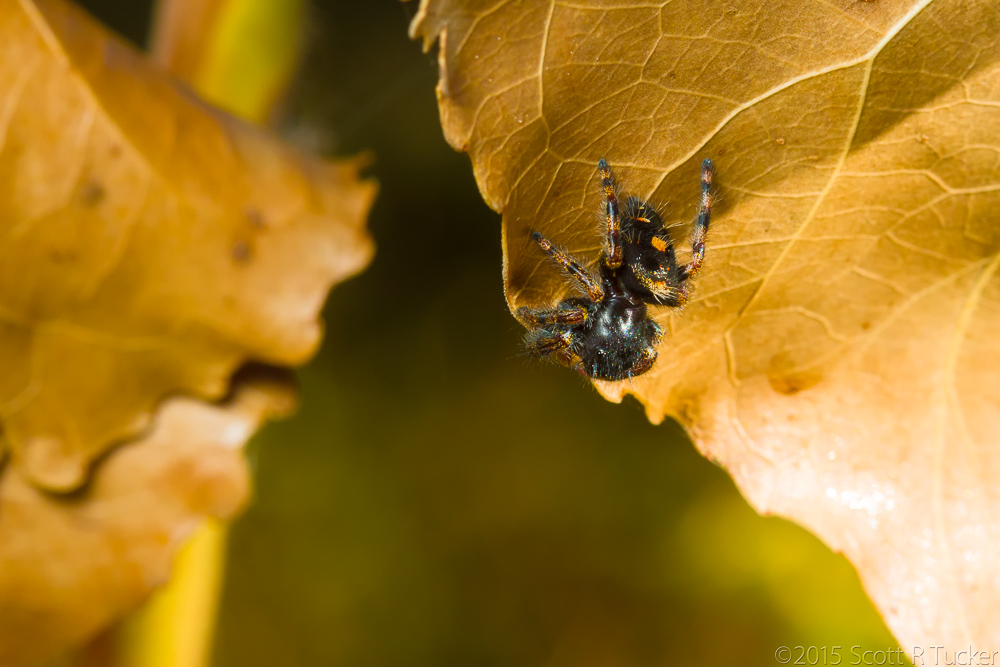
Bold jumping spider, Phidippus audax
"This bold jumping spider was elusive, to say the least. Every time I got close enough to try and shoot macro he went undercover. Amazingly, he was sharing these same leaves as territory with a long-jawed orb-weaver — that could have been the reason he was so skittish. (Fall color backdrop compliments of nature.)" — Scott Tucker [Credit: ©Scott Tucker]
Guardian of Rainbows
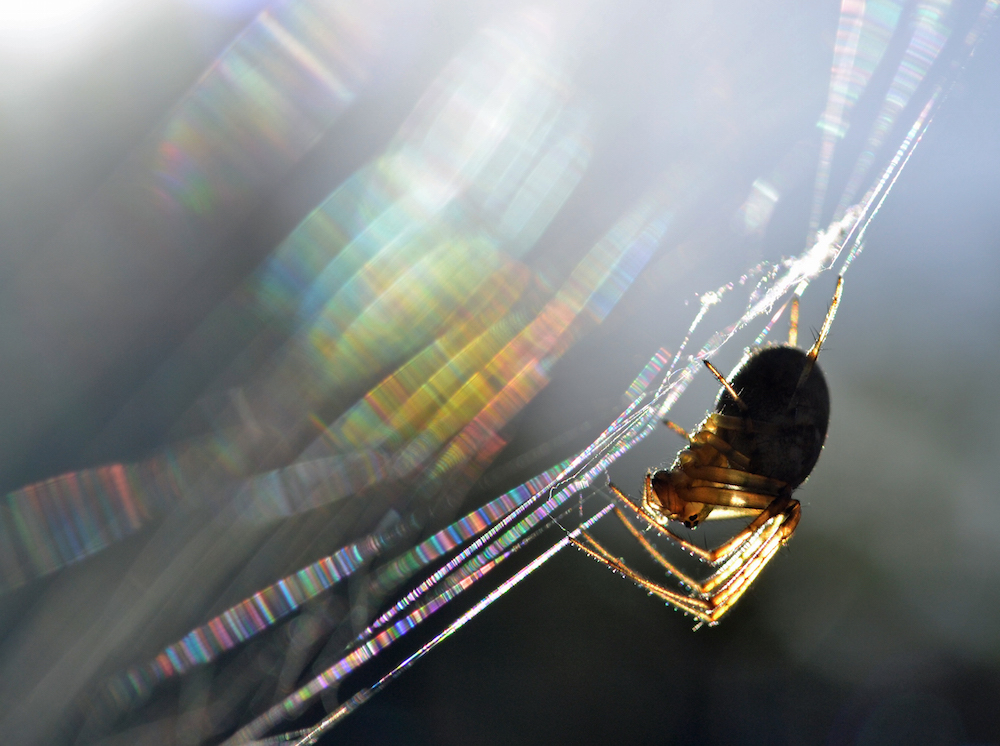
Orb-weaver, Metellina segmentata
"This is an orb-weaver type spider. The species is Metellina segmentata, and this is a female sitting in the center of her perfect orb web [in County Down, Northern Ireland]. I love how these spiders give the photographer an opportunity to take a picture of a natural history subject next to the abstract image that the web makes in the low angle sun." — Conall McCaughey [Credit: ©Conall McCaughey]
Sunlit Spider
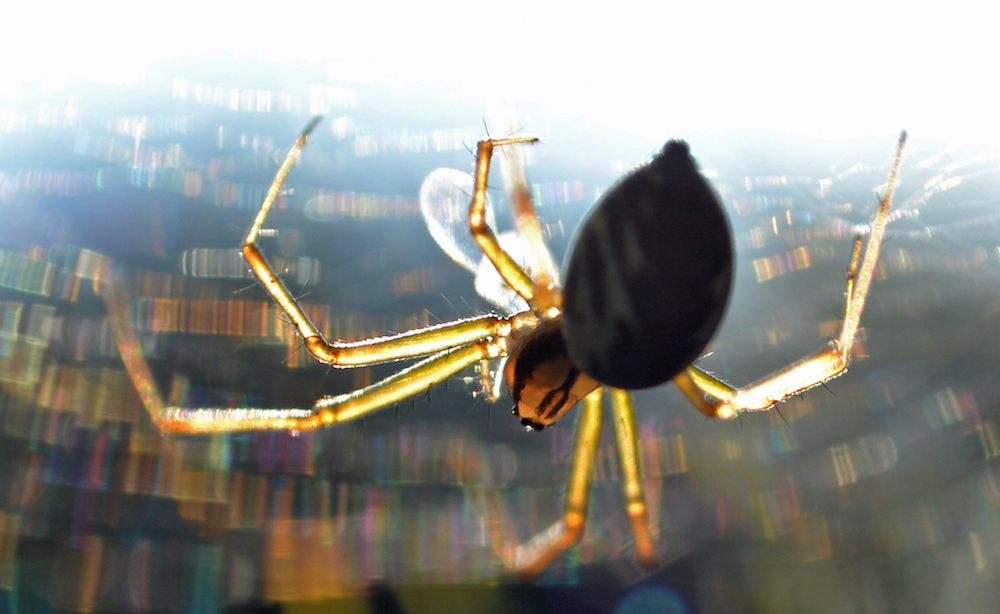
Sheet web spider, (possibly) Linyphia triangularis
"I love to get the morning sun behind the web and find some colored rainbows due to the refraction of the sunlight in the spider silk strands." — Conall McCaughey [Credit: ©Conall McCaughey]
Spider Selfie
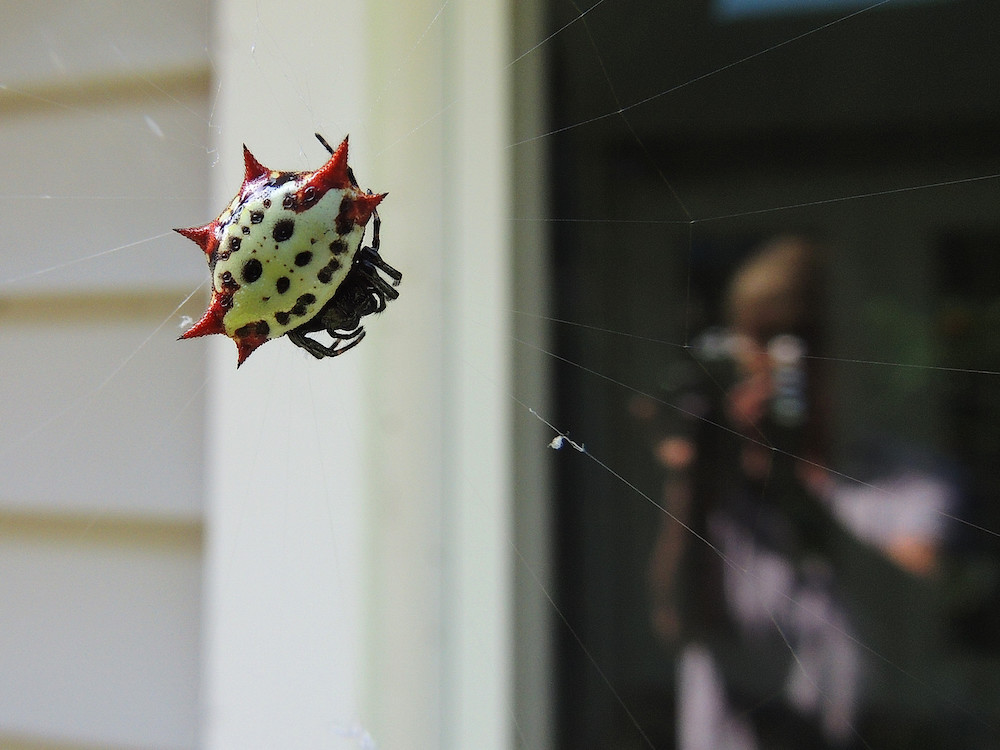
Crablike spiny orb-weaver, Gasteracantha elipsoides
"I didn't know I had also taken a selfie until I pulled up the image on my computer…this is a female crablike spiny orb-weaver. They are about 0.38 inches (8-10mm). She will spin a new web every evening and stand head downward near the center. The male is much smaller at 0.06-0.12 in. (2-3mm)." [Credit: ©Mary Wolf]
Pink-Toed Beauty

Pinktoe tarantula, Avicularia avicularia
This pinktoe tarantula is native to Central and South America but can commonly be found in pet stores. The photo comes from Daniel Thombs, an Arachtober member who typically photographs native species in Rhode Island, in the northeastern United States. [Credit: ©Daniel Thombs]
Center of Attention
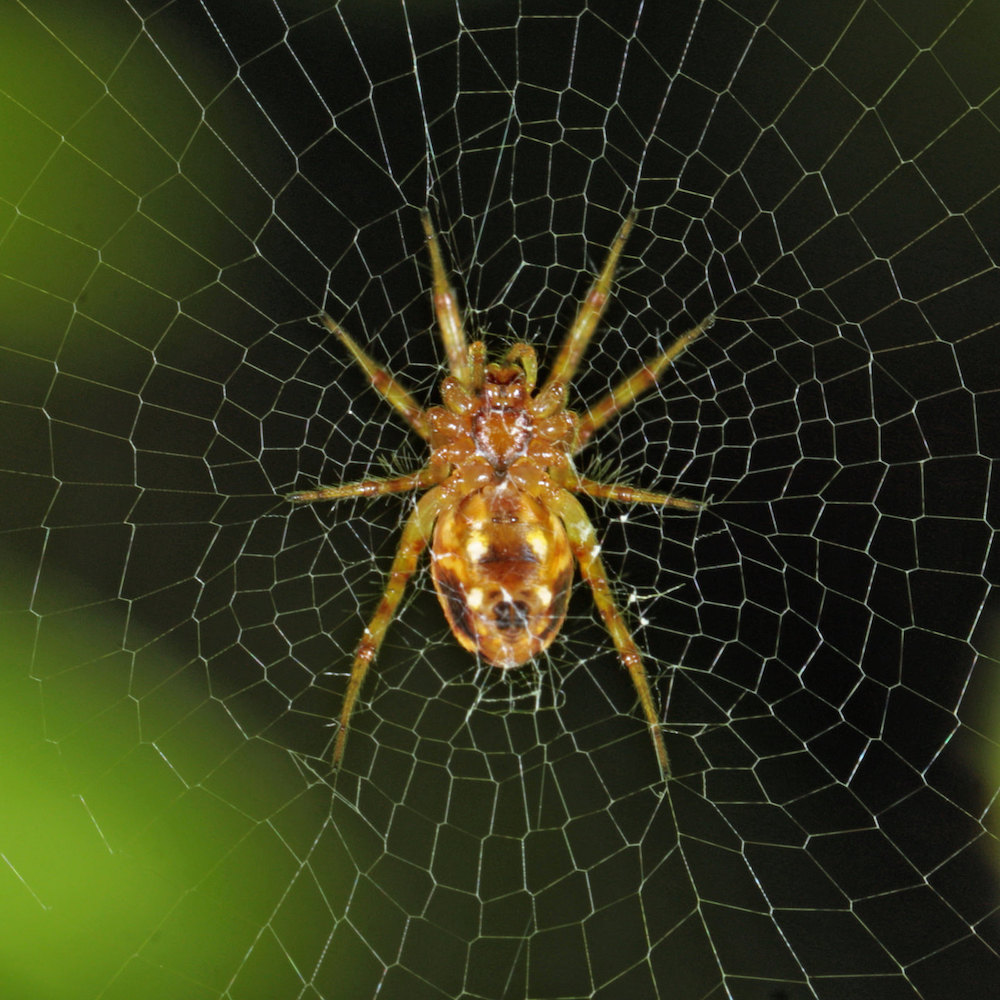
Orb-weaver
"Orb-weavers create perfect spiral webs, but the centers are often in a geometric pattern for stability. This is a very young spiderling, so it appears to be about the same size as the center [of the web], which is often small in itself." – Daniel Thombs [Credit: ©Daniel Thombs]
Big Appetite
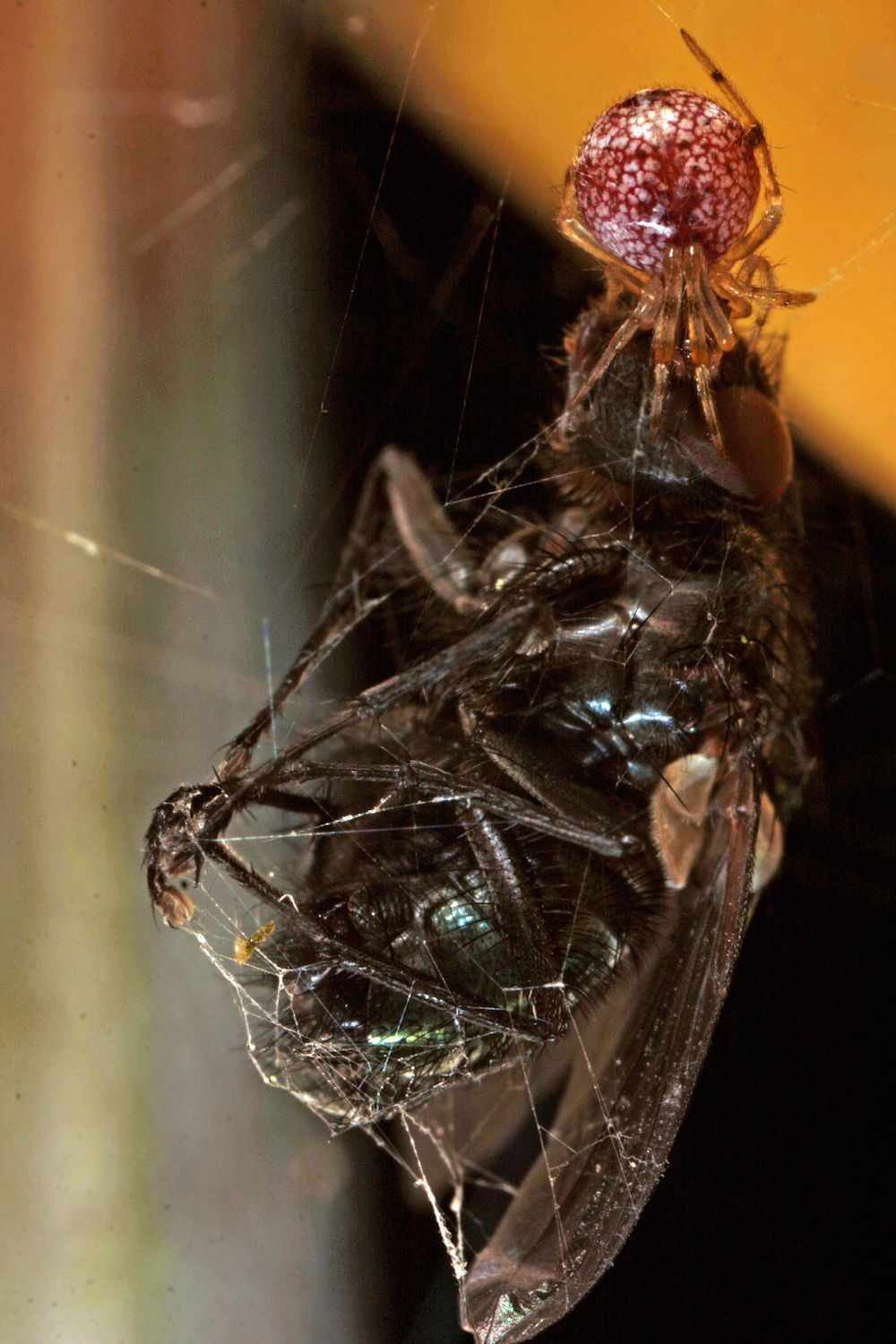
Cobweb spider, Theridon sp.
"[The cobweb spider] generally lives under some form of protection and creates sticky, erratic webs rather than the perfectly flat, ornate ones of the orb-weavers. In this web, it managed to catch a fly many times larger than itself." – Daniel Thombs [Credit: ©Daniel Thombs]
Scallywag Spider
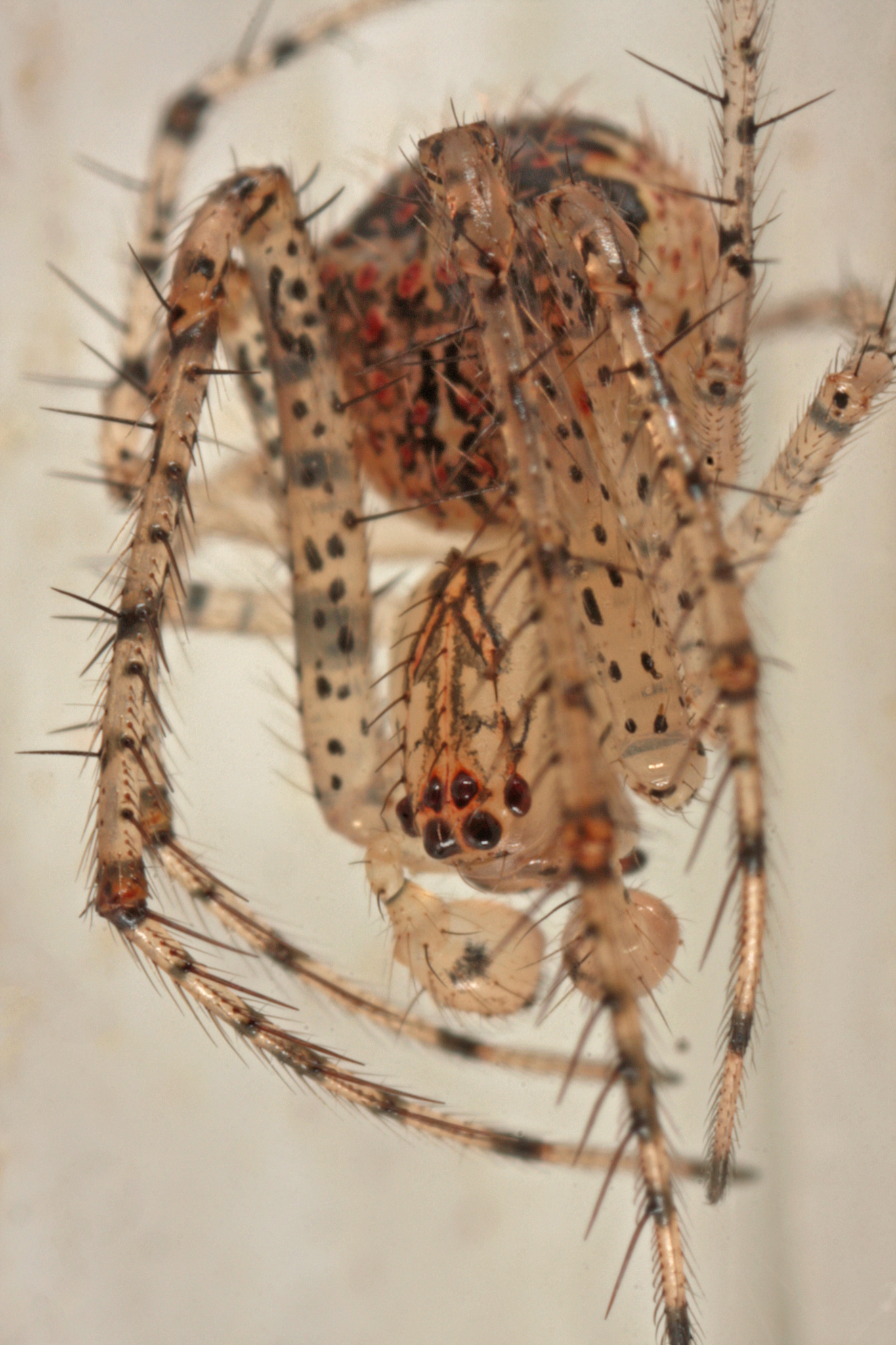
Pirate Spider, Mimetus notius
"[The pirate spider] occurs near (and eats) other spiders — primarily cobweb and orb-weavers, since they stay put and aren't travelers like wolf spiders, crab spiders, etc." – Daniel Thombs [Credit: ©Daniel Thombs]
Trashy Arachnid
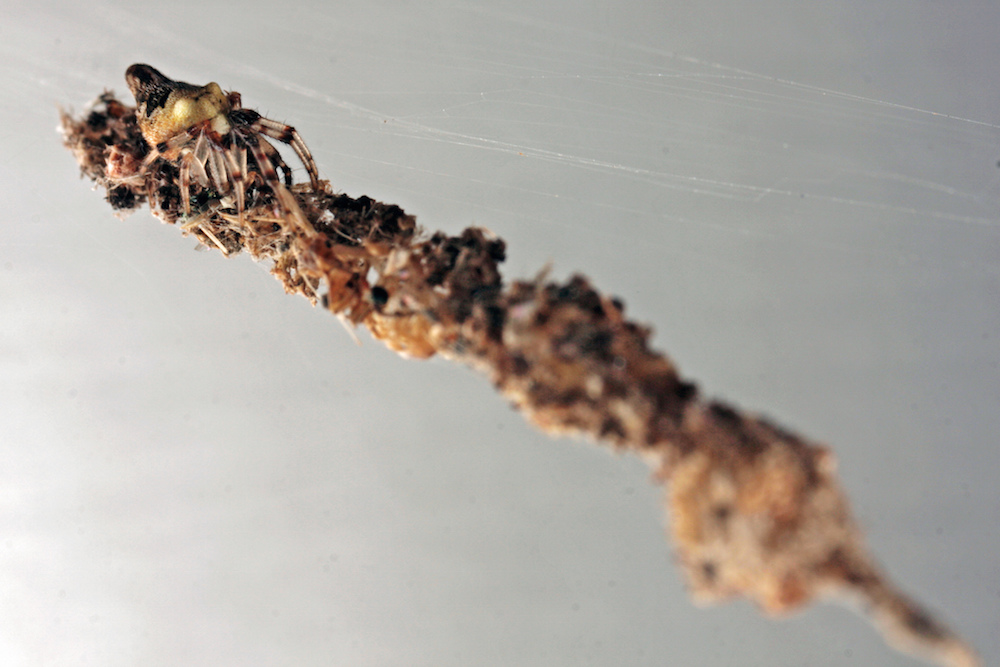
Trashline orb-weaver, Cyclosa conica
Trashline orb-weavers like this one reuse the bodies of their prey to camouflage themselves on their webs. More information about these savvy spiders can be found on Bug Eric, the blog maintained by entomologist Eric R. Eaton. [Credit: ©Daniel Thombs]
Crossing Paths
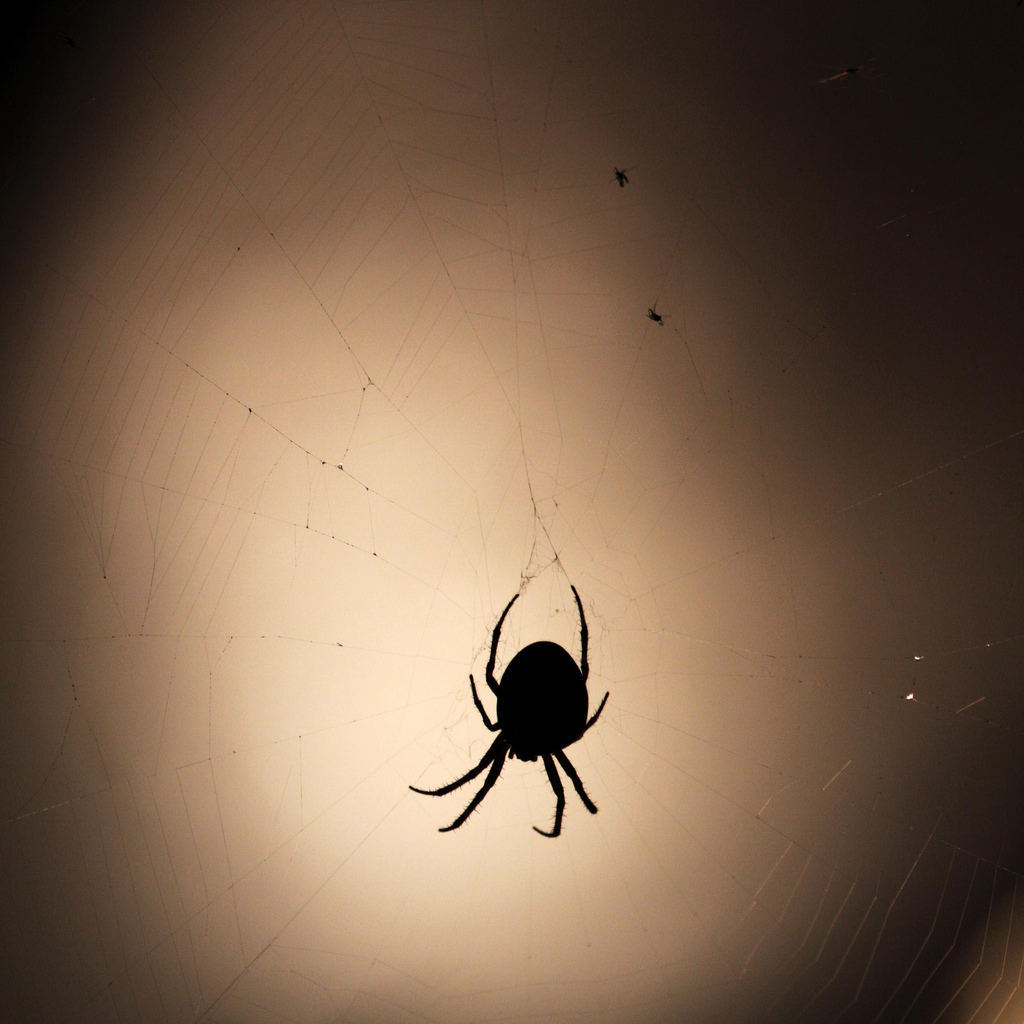
Cross spider, Araneus diadematus
"Saw this one outside around 8 p.m. and knew I had to try and get a shot." – Daniel Thombs [Credit: ©Daniel Thombs]
Action Shot
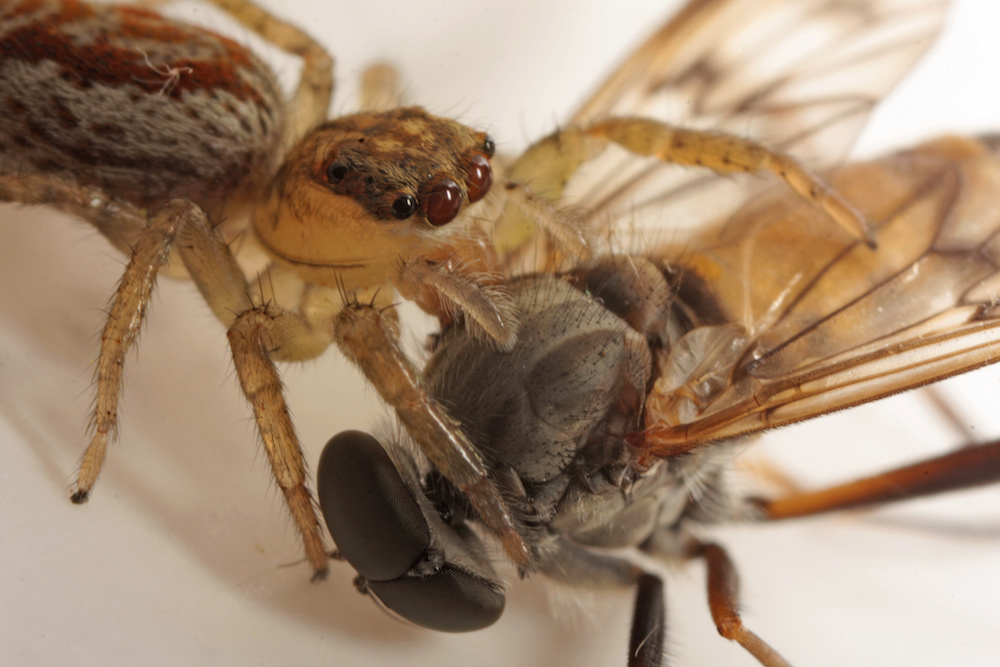
Dimorphic jumper, Maevia inclemens
A jumping spider takes on an unfortunate fly. [Credit: ©Daniel Thombs]
Follow Elizabeth Palermo @techEpalermo. Follow Live Science @livescience, Facebook & Google+.

Elizabeth is a former Live Science associate editor and current director of audience development at the Chamber of Commerce. She graduated with a bachelor of arts degree from George Washington University. Elizabeth has traveled throughout the Americas, studying political systems and indigenous cultures and teaching English to students of all ages.










